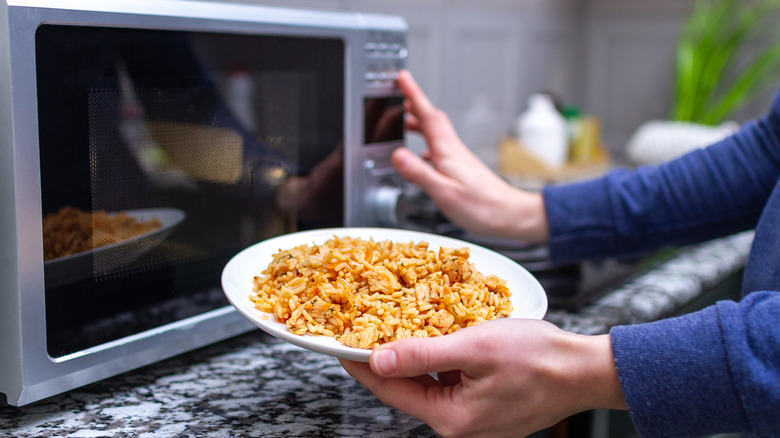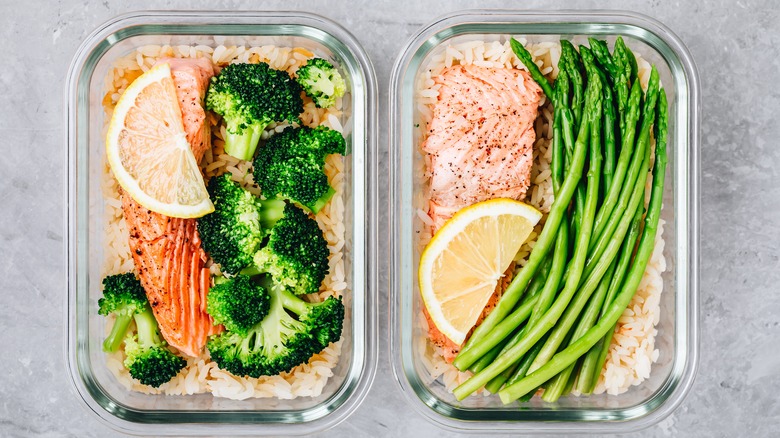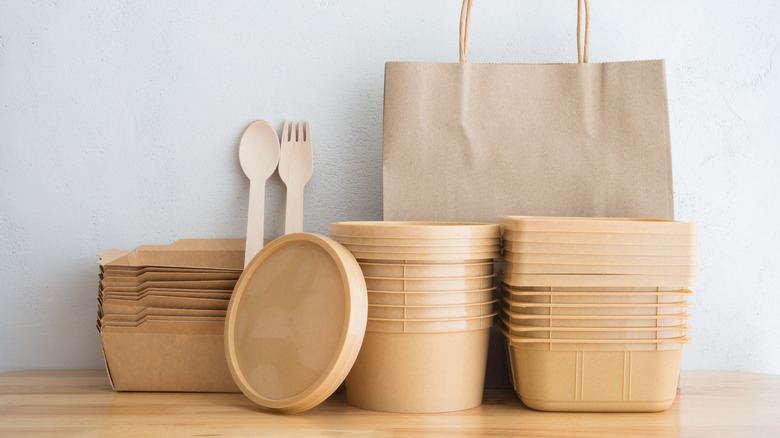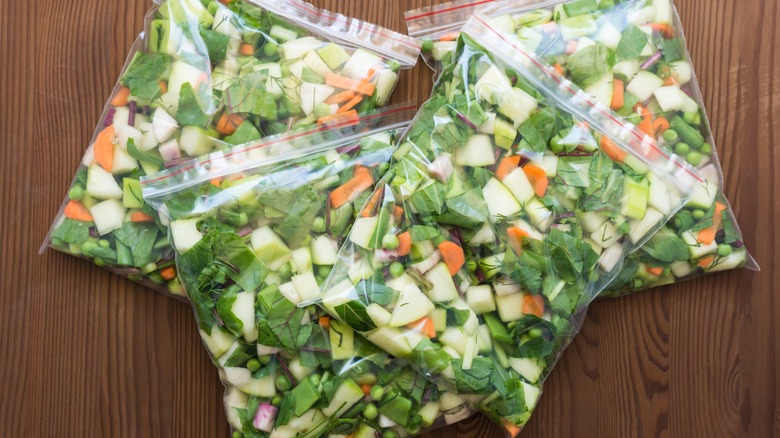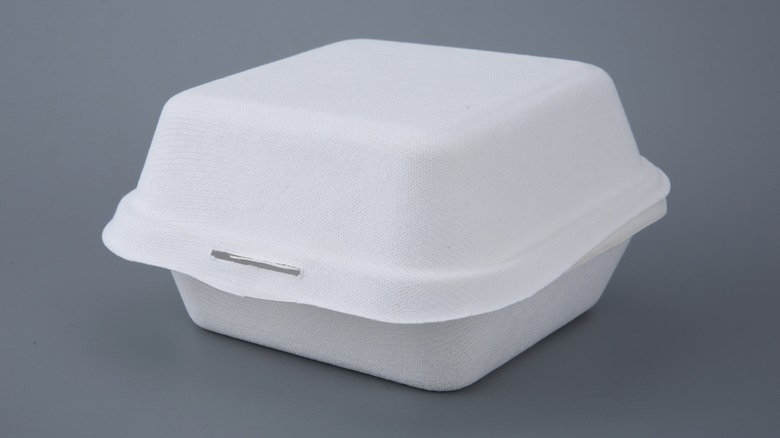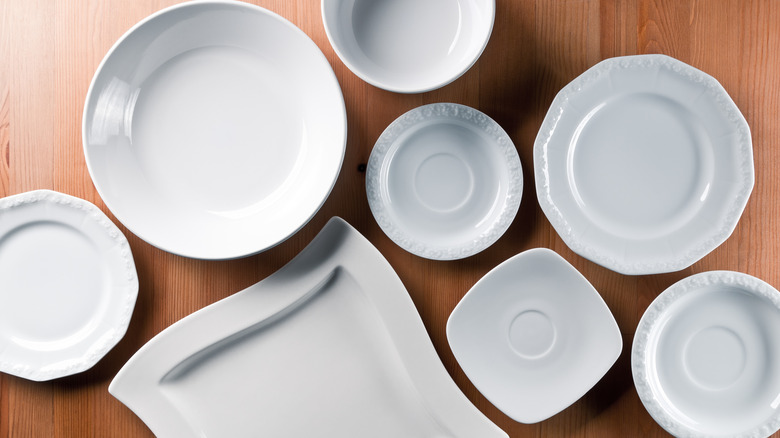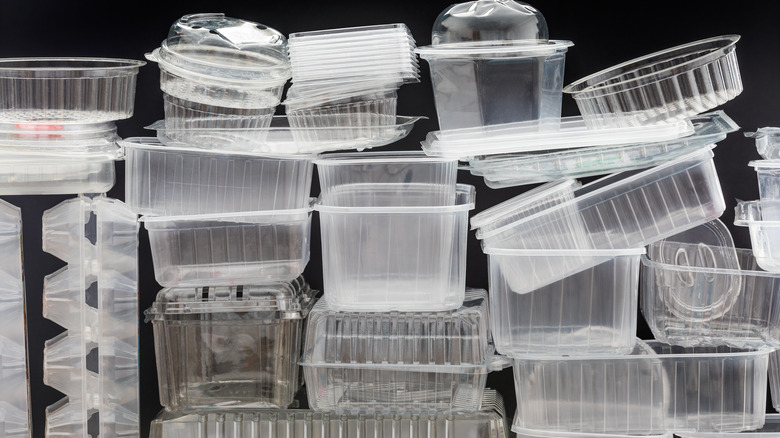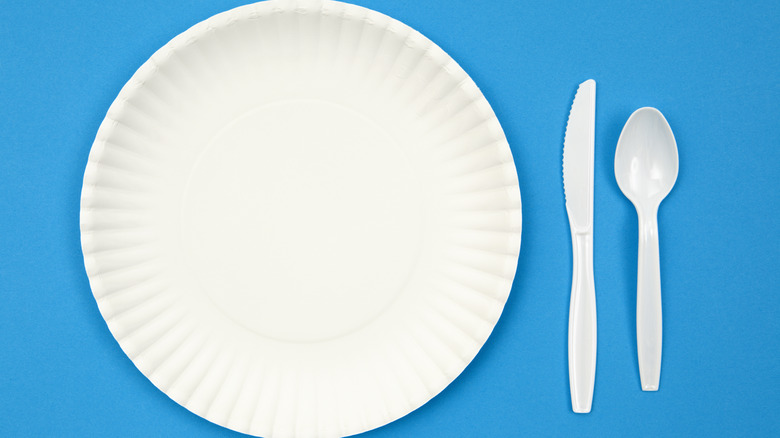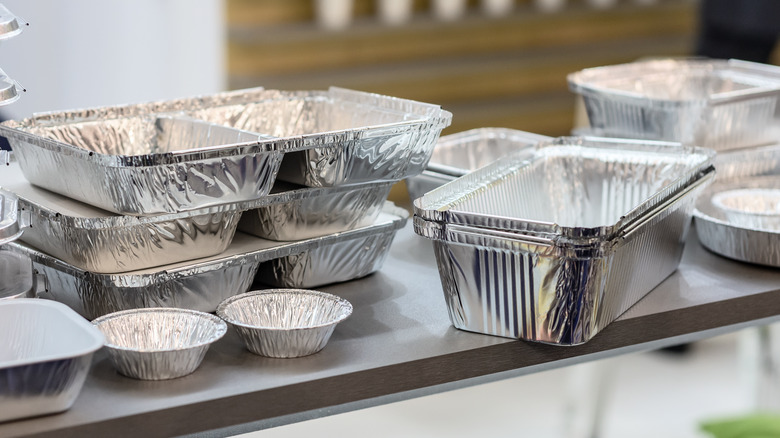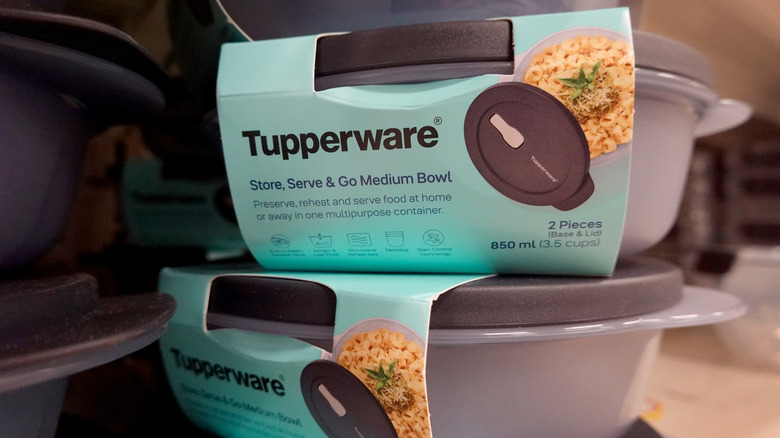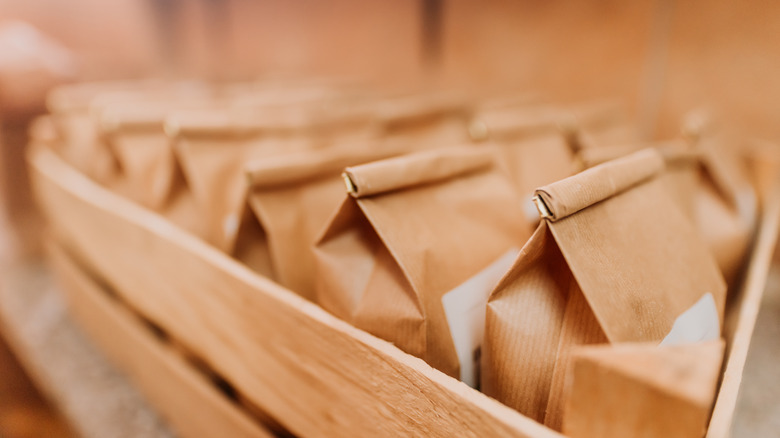Types Of Containers You Should And Shouldn't Put In The Microwave
Microwaves may make our lives infinitely easier, but if we place the wrong container in them, things can go drastically wrong. Not all containers are compatible with the appliances' heating method — bringing food up to temperature via electromagnetic radiation. This radiation spurs the water molecules in the food into action, the heating of which can end up deteriorating your food's vessel: In the case of some plastics, for example, the one-two punch of electromagnetic and water activity can cause them to crack and release chemicals, which may then affect your food. Metal containers, on the other hand, may simply be too good at reflecting heat away from them, which can then result in the microwave overheating.
It's not all doom and gloom, though. Some containers are perfectly suited for your humble microwave oven and can allow your food to heat through while they remain intact. Some of these containers might be pretty surprising, too: If you've ever shied away from putting a paper bowl in the microwave, now's the time to start doing it. To help you avoid making the wrong choice with your containers, and start making the right ones, we've put all the materials you should and shouldn't put in the microwave in one place.
Should: Microwave-safe glass containers
The question of whether to put glass in the microwave or not comes up a lot, and unfortunately, there's not a one-size-fits-all answer. If your glass is marked as "microwave-safe," though, you should feel pretty confident about using it to reheat your salmon and asparagus. These types of containers are often made from borosilicate glass, a type of glass that's able to withstand thermal shocks more effectively. Borosilicate glass is used to make lab equipment, as well as glass casserole dishes and some types of water bottles and wine glasses, and it's perfect for the ultra-quick rises in temperature your microwave can produce.
Using glass over other containers in the microwave also helps to contain your food better, as it won't bend or become pliable like other materials. This means that when you come to remove it, you won't have to worry about spills. It's worth remembering, though, that not all glass is made from borosilicate, so unless your manufacturer's instructions explicitly state that it can be used in the microwave, you should avoid it. Otherwise, the glass your container is made from may not be as thermal shock resistant and could shatter. Always look for a "microwave-safe" label on your container, too.
Shouldn't: Compostable containers
Compostable containers may be good for many things, but they're not great for putting in your microwave. These containers tend to use fiber-based materials like wood pulp, but which have a coating of plastic over them that helps them to stay waterproof or to keep from absorbing food moisture. When you heat them in the microwave, though, this plastic coating can quickly transfer from the container to your food, leaching unpleasant chemicals that you probably don't want to eat into your meal.
Compostable containers can also be made from bioplastics, but again, these tend to leach into food when heated up. If you have leftover food in a compostable container, it's always best to decant this into a different vessel before you reheat it. You can take comfort, though, in the fact that the compostable container won't be polluting the planet: These things tend to break down fairly quickly. Just make sure you're not recycling them and instead placing them in your compost heap or taking them to an industrial composting center.
Should: Ziploc bags
Ziploc bags are kinda the best, folks. They're easy to store, simple to use, and able to hold pretty much any food item. The best part, too, is that Ziploc's bags are microwave-safe and can be used as containers to heat your food, without having to decant it to some other dish.
It's important to remember that this may not be the case with all plastic food bags. While the Ziploc brand explicitly creates their bags to be microwave-friendly, other products may not be made from as robust materials and thus more prone to softening, melting, or leaching plastic into your food. Before throwing an alternative-brand bag in the microwave, check its original packaging.
Crucially, Ziploc bags are way softer than other containers, so certain precautions should be taken. These bags aren't designed to stand up and have an annoying knack for spilling everywhere — particularly if you don't pop them open beforehand to let steam escape, which can cause them to burst. So, open them about an inch and place them upright in a hard microwave-safe container. There's nothing stopping you from reusing zip-top bags, either, but avoid putting them in the microwave for too long, as the food inside can overheat, potentially causing the bag to soften too much.
Shouldn't: Styrofoam
Styrofoam is the container material of choice for many takeout places across the land. Something you need to know when ordering takeout, though, is that if there's a choice of alternative container, you should take it. While Styrofoam is good at keeping your food hot in the short term, reheating it is hugely risky. Interestingly, what we know as "Styrofoam" is a type of polystyrene foam called EPS (although most of us just call it, y'know, Styrofoam). EPS containers, however, are particularly prone to cracking when heated in the microwave, which can cause food spillage or burns.
More worryingly, heating these containers may cause the release of styrene, a compound in the foam which has been linked to the development of several types of cancer, according to research published in Epidemiology. This styrene can work its way into your food, and then into your body. If that all wasn't bad enough, Styrofoam can also wreak havoc on the environment, contributing to pollution and clogging up landfills, as well as causing harm to animal and marine life. It's little wonder that there's been an industry-wide shift to move away from Styrofoam takeout containers and to healthier, less problematic alternatives.
Should: Ceramic dishware
Ceramic dishware is particularly well suited to being heated in the microwave. The material that makes plates, bowls, and mugs is usually designed to withstand higher temperatures, and it is especially good at insulating heat, which means that bowl of soup you're heating up will stay warm for longer after it's left your microwave oven.
However, as with glass, certain rules apply. First and foremost, you should always make sure that your ceramics are microwave-safe and designed to withstand heat. Otherwise, your container runs the risk of cracking when it's shot up to a microwave's high temperatures. It's also worth bearing in mind that handmade ceramic items, like pottery bowls or mugs, may not have the same thermal shock capacity as a professionally fired item and could well shatter upon being heated. Finally, items with metallic inlays or paints can cause the electromagnetic waves from your microwave to reflect, potentially causing damage to your appliance — so use an ordinary mug for that double chocolate mug cake.
Shouldn't: Plastic takeout boxes
For your indulgent Thai and Chinese takeout orders, a plastic box is usually the vehicle of choice. Thinking they can be microwaved makes sense: After all, they house hot food from your favorite restaurant, so surely they should be able to withstand that same food heating back up, right? While this may be the case, problems can arise when you start to reheat them. Popping a takeout box in the microwave and reheating it can cause toxins in the plastic to leach into the food inside. In a study published in Environmental Science & Technology Letters, it was found that these chemicals can leach into food from containers over time regardless of whether they've been heated — but that heating them can hasten this transfer.
Takeout containers also tend to be made of pretty thin, flimsy plastic, and while they can withstand high temperatures, there's always the risk of them becoming too soft or cracking. There may be certain exceptions to this, though, and if your takeout container is explicitly marked as microwave-safe, you could be good to go. However, if in doubt, pop your food into a different vessel.
Should: Paper plates and bowls
Paper objects and your microwave don't immediately seem to go together — but somewhat bafflingly, paper plates and bowls tend to fare pretty well in the appliance. Plain white, unprinted paper food containers are usually safe in your microwave and don't bear any risk of breaking down. The same goes for plain white napkins, which can be microwaved largely without issue (provided that you're following the timing rule for putting paper towels in the microwave, that is).
As ever, though, there are a few "buts" here. While plain paper plates and bowls are usually safe, some can be covered with a layer of protective plastic to stop them from getting soggy, which can end up in your food. Printed or patterned paper plates and bowls may also have plastics or dyes that create issues. It's also worth thinking about the food you're planning on heating up; if you're trying to reheat something wet or greasy, this can end up soaking through the paper. Above all else, though, check if your container is microwave-safe.
Shouldn't: Foil containers
Ah, foil. We've all seen those videos of what happens when you put a ball of foil in the microwave. (Spoiler alert: It catches on fire.) So you probably wouldn't think that foil containers are any different — and you'd be right. When you place a thin piece of foil in your microwave, it creates a flow of electricity through the metal itself. This flow quickly overheats the foil and can lead to a fire, thereby ruining your dinner, wrecking your appliance, and potentially causing even more damage.
In the case of foil containers, this is only made more likely by their design. Foil food containers often have crinkles and wrinkles built in to them, but these irregularities cause sparks to form on their surface, increasing the chance that they'll set something alight. Somewhat interestingly, while you can use flat pieces of foil to "shield" food while it's in the microwave, positioning it too close to the microwave walls can create a hazard, as well. In our opinion, it's far easier to avoid the risk entirely and just stick to heating your food differently. While aluminum foil might be good for keeping food warm on the go, it's not great for your microwave.
Should: Newer Tupperware containers
Plastic has a bad rep for microwave use, and rightly so. However, it's important to remember that not all plastic is dangerous in your appliance, and some manufacturers, like Tupperware, are creating microwave-friendly food containers. These containers are built to withstand a fairly high temperature and have built-in steam valves to stop heat from building up too much and causing an explosion in your microwave.
Tupperware has also made significant efforts to reduce the toxicity of its products and stopped using BPA in its food containers in 2010. The same can't be said, however, for older Tupperware containers, which may still have BPA in them — or for other manufacturers, which may still make their products with the chemical (which might then end up in your food). It's important to note, too, that while Tupperware's items are created with higher temperatures in mind, they're not invincible. Heat them for too long, or forget to allow steam to escape, and they could well warp or melt. They are made from plastic, after all.
Shouldn't: Brown paper bags
It can seem a real hassle to remove your lunch from its brown paper bag to heat it up when you could just throw it in the microwave and hit the start button. However, make sure you take that extra step, or you could have a fire on your hands. Brown paper bags are unsuitable for microwave use because they're not built to last and are way too thin to withstand the appliance's heat. As a result, they can quickly become overwhelmed by the rapidly rising temperature of your food and burn.
Additionally, while brown paper bags can look pretty innocent, they can often contain chemicals. These chemicals, when heated up, can then either work their way into your food or release fumes through your kitchen. Incidentally, there are some paper bags out there that have been designed to be microwave-safe. If you're in any doubt about the safety of your bag, though, or if it doesn't have "microwave-safe" printed on it anywhere, throw it out and heat up your food in something else.
